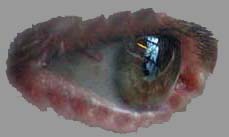

 |
|
|
Testing the Waters— Palestine & Israel, 2006 |
|
|
Journal, April 20 & 23, 2006 (edited May 1) —HaifaPhotos: Mediterrean beach Haifa journal—Part five—Beach & Wadi SalibBy Skip Schiel THE BEACH The beach proved to be a good choice for a field trip. Being the end of Pessach holiday week, parts of it were thronged with families, couples, singles, all mixing together. How many were Palestinian and how many Israeli I do not know, might ask, but it didn't seem to matter—ah, coexistence in action. The restaurant area featured a large theater light shining into the sea, anomalously. It was as if producing the sunset. The sky was partially overcast, lending a soft touch to the light, a bit pastel. Earth mounds moved people up to make odd angles, and acted as platforms for photographers. One activity of the workshop for Baladna I was leading was back light. At the end of the session, nearing 8 pm, the sun had been below the horizon for one hour but the sky continued to glow with the proverbial Mediterranean light. Perfect for backlighting, but challenging to even the most skilled photographers. The task for the first location was choose a location and make a series of photos not leaving that spot. For the 2 nd , it was juxtaposing 2 or more things and for the third, backlight. With the instructions that I'd written and handed out (anticipating we'd not be able to stay together or communicate except by mobile phone), I included principles ( follow the light, choose the position and time, and design the photo) and tips (both eyes open, etc) and ideas for activities (metaphor, etc). I'll try to picture the beach, comparing it later with my photos. It is long, this public section, to the left of the port as you face it, a considerable distance away from the city center by road, maybe 10 km. To reach it you drive around Carmel mountain, along the periphery of what might be termed a cape, no direct path to it that I know of from the center of the city. The beach long and fairly narrow. The land rises abruptly about 1/2 km behind the water. A hotel, the Meridian, sits squarely in the way of the sea. Oola told me that the plan the hotel people submitted to the municipality showed the hotel oriented sideways, but in construction it was turned to be even more out of place. It also blocks the view of the homeowners behind it. Parking is on both sides of the hotel and in front—thus, vehicles dominate the scene. A series of stubby columns, inexplicable to me, sits to the side of the hotel. Then the public area begins, with the mounds I mentioned, and sand. I believe this includes supervised swimming. The beach is continually sandy as far as we explored. Drive a short distance, maybe 1 km, along newly renovated roads lined with newly planted palm trees, and you're at the kiosk area, a strip of eateries. You can eat indoors or out, many tables going down to the water. Camels predominate here—not the living, breathing sort, but the smoking sort: the camel cigarette in signs clog up this stretch of beach. More troubling to me was congestion and with it the risk of bombing. Since the recent bombing in Tel Aviv, I had to wonder, here also? But few seemed concerned, outwards. No security, no apparent fleeing away from each other. But I scrammed from the crowded area as soon as possible. Further yet, going south—the beach faces west, orienting it perfectly for sunsets—you reach a less populated section of shore, called Students' Beach. It features a small forest of trees, including palms. It is also well named. When we arrived, we parked next to a car holding a couple who seemed to be struggling with how to fuck in such a confined space. And so it went, leading a field trip to a ravishingly gorgeous section of the Promised Land. Is Dostoevsky correct in claiming: "Beauty will save the world."? Haifa, April 20, 2006 WADI SALIB Wadi Salib turned out to be another fine choice for a photo workshop field trip: an inner city section, partially demolished, fancy expensive buildings going up, including "The roof for demobilized soldiers," flea or used materials market, old Arab buildings, a mosque, and a few people. As with Wadi Rushmia, and to some extent, Wadi Nisnas, the dominant Israeli government is pushing out indigenous people and converting what had been a livable and affordable space into upscale commercial and residential property. It illustrates well what I see as a central dynamic of life for Palestinians in Israel: altho citizens, they have severely constricted rights. In this case the right to housing. I'm reminded again of District Six in Cape Town ,South Africa, a region historically known for its burly living, shared by all sorts of people—apartheid be gone in District Six! Then, because of it being a prime real estate location, the apartheid government demolished homes, stopping only at places of worship, churches and mosques, when people resisted by putting their bodies in front of the bulldozers. Sustained resistance prevented the apartheid government from significant building in District Six. Now, with the new post apartheid government, District Six is an outdoor and indoor museum, dedicated to keeping alive the memories of those who once lived there. (Or at least that was the condition when I last visited, in 1999.) Will this moment ever arrive in Israel-Palestine? Haifa, April 23, 2006 LINKS |